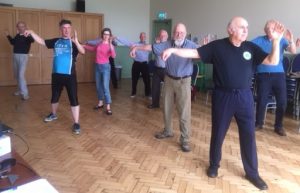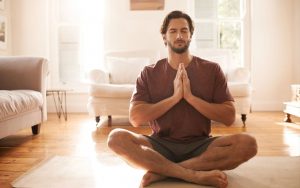Tai Chi Practice Improves the Symptoms of Multiple Diseases
By John M. de Castro, Ph.D.
“In addition to easing balance problems, and possibly other symptoms, tai chi can help ease stress and anxiety and strengthen all parts of the body, with few if any harmful side effects.” Peter Wayne
Tai Chi is an ancient mindfulness practice involving slow prescribed movements. It is gentle and completely safe, can be used with the elderly and sickly, is inexpensive to administer, can be performed in groups or alone, at home or in a facility or even public park, and can be quickly learned. In addition, it can also be practiced in social groups without professional supervision. This can make it fun, improving the likelihood of long-term engagement in the practice. Indeed, studies have shown that Tai Chi practice is effective in improving the symptoms of many different diseases. The evidence is accumulating. So, it makes sense to step back and summarize what has been learned about the effectiveness of different Tai Chi practices for different disease conditions.
In today’s Research News article “.Clinical Evidence of Tai Chi Exercise Prescriptions: A Systematic Review” (See summary below or view the full text of the study at: https://www.ncbi.nlm.nih.gov/pmc/articles/PMC7972853/ ) Huang and colleagues review and summarize the published randomized controlled trials on the effectiveness of different Tai Chi practices for different disease conditions. They identified 139 published randomized controlled trials utilizing a number of different Tai Chi styles and numbers of forms. Yang style was by far the most frequent style and 24 forms was the most frequent number of forms employed.
They report that the published research found that Tai Chi practice produced significant improvement in the symptoms of musculoskeletal system or connective tissue diseases such as osteoarthritis, fibromyalgia, and chronic low back pain.; on circulatory system diseases such as hypertension, stroke, coronary heart disease, and chronic heart failure; on mental and behavioral disorders such as depression, cognitive impairment, and intellectual disabilities; on nervous system diseases such as Parkinson’s disease, dementia, and sleep disorders; on chronic obstructive pulmonary disease (COPD); on endocrine, nutritional, or metabolic diseases such as type 2 diabetes and metabolic syndrome; on the physical and mental state of cancer patients, and on traumatic brain injury and urinary tract disorders; on balance control and flexibility and falls in older adults.
These are remarkable findings. Tai Chi practice appears to be a safe and effective treatment for the symptoms of a wide variety of diseases. It doesn’t cure the disease. Rather if alleviates the symptoms. It is not known the mechanisms by which Tai Chi has these benefits. Future research needs to further explore what facets or effects of Tai Chi practice are responsible for the disease symptom improvements.
So, Tai Chi practice improves the symptoms of multiple diseases.
“Tai Chi and Qigong are evidence-based approaches to improve health-related quality of life, and they may be effective for a range of physical health conditions.” – Ryan Abbott
CMCS – Center for Mindfulness and Contemplative Studies
This and other Contemplative Studies posts are also available on Google+ https://plus.google.com/106784388191201299496/posts and on Twitter @MindfulResearch
Study Summary
Huang, J., Wang, D., & Wang, J. (2021). Clinical Evidence of Tai Chi Exercise Prescriptions: A Systematic Review. Evidence-based Complementary and Alternative Medicine : eCAM, 2021, 5558805. https://doi.org/10.1155/2021/5558805
Abstract
Objectives
This systematic review aims to summarize the existing literature on Tai Chi randomized controlled trials (RCTs) and recommend Tai Chi exercise prescriptions for different diseases and populations.
Methods
A systematic search for Tai Chi RCTs was conducted in five electronic databases (PubMed, Cochrane Library, EMBASE, EBSCO, and Web of Science) from their inception to December 2019. SPSS 20.0 software and Microsoft Excel 2019 were used to analyze the data, and the risk of bias tool in the RevMan 5.3.5 software was used to evaluate the methodological quality of RCTs.
Results
A total of 139 articles were identified, including diseased populations (95, 68.3%) and healthy populations (44, 31.7%). The diseased populations included the following 10 disease types: musculoskeletal system or connective tissue diseases (34.7%), circulatory system diseases (23.2%), mental and behavioral disorders (12.6%), nervous system diseases (11.6%), respiratory system diseases (6.3%), endocrine, nutritional or metabolic diseases (5.3%), neoplasms (3.2%), injury, poisoning and certain other consequences of external causes (1.1%), genitourinary system diseases (1.1%), and diseases of the eye and adnexa (1.1%). Tai Chi exercise prescription was generally classified as moderate intensity. The most commonly applied Tai Chi style was Yang style (92, 66.2%), and the most frequently specified Tai Chi form was simplified 24-form Tai Chi (43, 30.9%). 12 weeks and 24 weeks, 2-3 times a week, and 60 min each time was the most commonly used cycle, frequency, and time of exercise in Tai Chi exercise prescriptions.
Conclusions
We recommend the more commonly used Tai Chi exercise prescriptions for different diseases and populations based on clinical evidence of Tai Chi. Further clinical research on Tai Chi should be combined with principles of exercise prescription to conduct large-sample epidemiological studies and long-term prospective follow-up studies to provide more substantive clinical evidence for Tai Chi exercise prescriptions.
https://www.ncbi.nlm.nih.gov/pmc/articles/PMC7972853/









